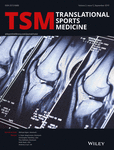Rhabdomyolysis in an elite dancer after training with electromyostimulation: A case report
Abstract
We report a case of lower limb rhabdomyolysis in an elite dancer after one training session of electromyostimulation (EMS). Due to immobilization after an overload injury in the left foot, EMS was used to counteract loss of muscle mass. The EMS training session was initiated shortly after the injury and consisted of two sets of activation of left leg quadriceps, shin, and calf muscles. Each set involved 25 repetitions with an EMS intensity varying between 15-30 mA (35 Hz). Workload was 6 seconds of activation and 7 seconds resting time. Each EMS-induced muscle contraction was stopped by voluntary co-activation of the various antagonist muscles to generate a maximal concentric-eccentric load on the muscle involved. About 36 hours after the training session, the dancer was admitted to hospital due to rhabdomyolysis. Creatine kinase (CK) levels reached a maximum of 26 200 IU/L, and the dancer was hospitalized for 4 days. With our case, we highly advocate for the development of safe and validated EMS training protocols. All personnel, manufactures, and athletes working with EMS should be aware of the potentially serious adverse events.
CONFLICT OF INTERESTS
None.




